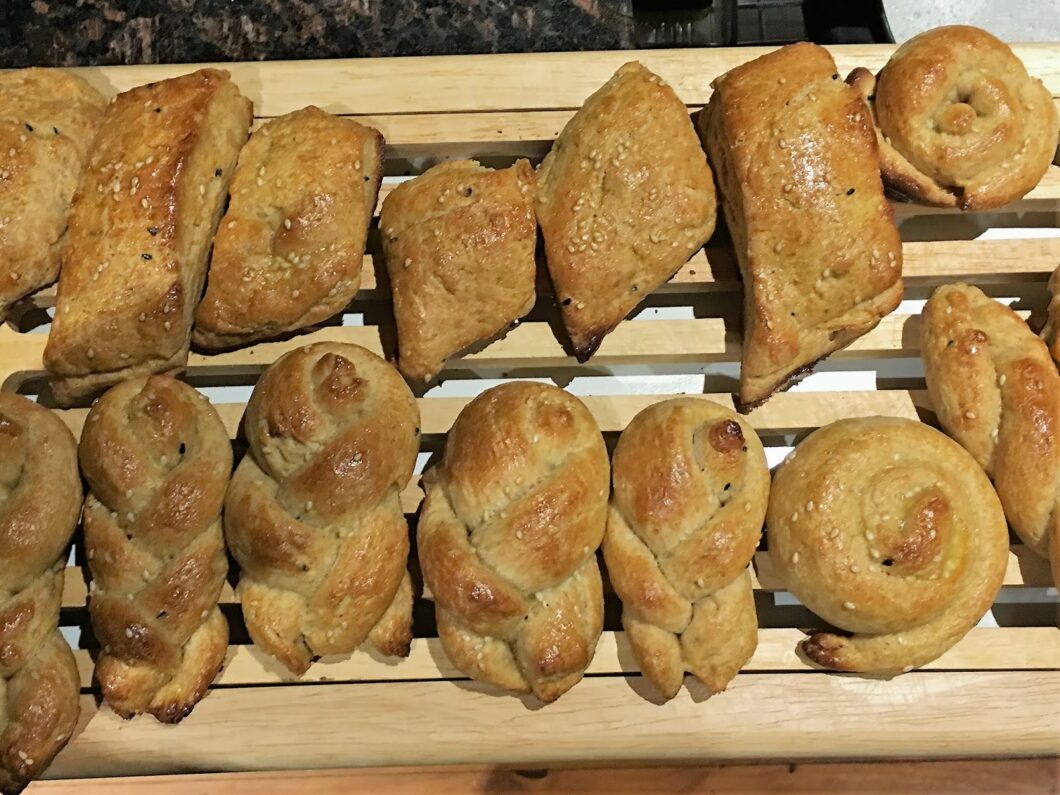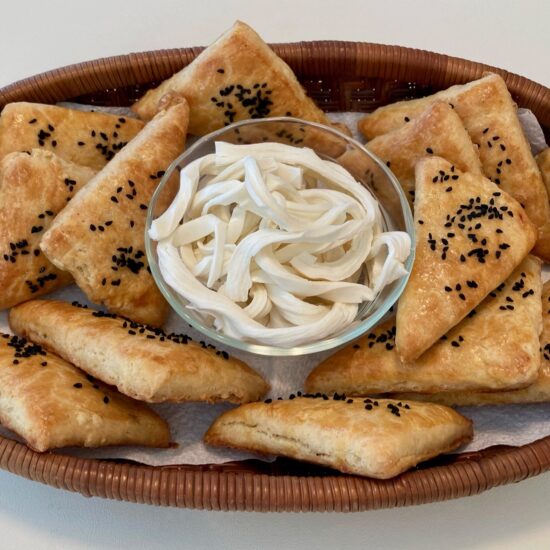Carolann Najarian is a woman of many talents – she is a
retired physician, author, philanthropist, and now, a choreg baker.
 |
| Carolann Najarian’s whole wheat choreg |
Over the years, Carolann and I have communicated about this-and-that via The
Armenian Kitchen.
Recently she wrote saying she wanted to try her hand at baking choreg.
She said her mother used to make a choreg which was not too sweet, somewhat
dry, a bit dense, and was formed into diamond shapes. She no longer had her
mother’s recipe – a family favorite – and turned to my website hoping to find a
recipe.
 |
| Kalonji seeds |
Her mother’s recipe sounded much like a recipe request I
received ages ago for a Kharpetsi-style chorag recipe called Koolunja, a word
she wasn’t familiar with. After reaching out to my readers about Koolunja, I
never had any responses. My research provided a clue about koolunja (aka
kalonji) and discovered it means ‘black seeds’.
Since black seeds are often an ingredient in chorag
recipes, I came to the conclusion that “koolunja” simply refers to these seeds
and is not really a recipe name.

For Carolann’s future use, I sent her a recipe for ‘Koolenja’ by Agnes Carman Hovsepian, from
the cookbook, ‘Armenian Cuisine – Preserving Our Heritage’, St. John’s Armenian
Church, Southfield, Michigan.
how it turns out. This will be a separate post.)
columnist in The Armenian Weekly), provided me with additional information about Koolunja:
koolunja and black caraway seeds are also referred to as sevakundig (sev
hundig) and nigella.”
choreg using whole wheat flour, and asked me for any tips.
for her assistance, meaning that after she experimented with the recipe, would
she please share her results. She agreed.
for all-purpose flour came from Better Homes and Gardens:
flour with whole wheat flour when baking. Blending whole wheat flour with
all-purpose flour will lighten the finished product while maintaining the
nutritional benefits of whole wheat. When baking, use half all-purpose flour
and half whole wheat flour. The end product might not look the same, and it
could have a coarser texture and less volume.”
choreg report:
 |
| Rachel and Nonny Hogrogian’s cookbook |
“I did make the half whole wheat/ half all-purpose flour
chorag and it is very good. I used the same recipe (almost) that I used last
time simply because I had made twice before and felt comfortable with it. It is
from Rachel and Nonny Hogrogian’s cookbook, ‘The Armenian Cookbook’.” Her
recipe, an adaptation of Rachel Hogrogian’s Choreg recipe, follows.
 |
| Carolann’s whole wheat choreg – hot out of the oven! |
Carolann Najarian’s Whole Wheat Choreg Recipe
(105-110°)
milk can be used)
**Important Messages Regarding Mahlab:
me two vital links regarding Mahlab:
you’ll definitely want to avoid mahlab. Please click here to find out why!
Directions:
ground mahlab, ground anise, and black seeds. Blend well. Make a well in the
center of the dry ingredients and pour in the yeast, 3 eggs, melted butter and
warm milk. Blend mixture by hand until a dough is formed.
sticking to the bowl, stop kneading immediately. Do not coat the bowl or
dough with oil. Cover the bowl with parchment paper and a clean towel; place it
into a warm oven heated to 150°F. Turn off the oven; allow dough to rise until
doubled in size – about 2 hours.
with your hands patting it down to about 3/4 inch thickness. Cut into squares,
triangles, or diamond shapes. Alternately, take a handful of dough, roll it
into a rope about 1 ¼” thick. Cut rope into 9” pieces; fold each piece in half
and twist it once.
piece with egg wash. Sprinkle tops with sesame seeds.
until golden brown.



I've been making choreg for many years and was never satisfied with the results until I tried the recipe in Armenian Cooking Today, a cookbook I've had since 1979. It turned out to be the best. My mother and I both made spiral and twisted shapes. Never thought of diamond shape, but I'll try it now. Looks beautiful.
The diamond shape certainly makes this an easy choreg recipe. I have the same cookbook – got it as a 1st Anniversary gift back in 1978!
Wonderful site. Thank you for these recipes.
My Mother use to roll the dough out into a large rectangle and then fold the rectangle into thirds. She would cut out diamond shapes and then let the shapes rise before cooking them. I have looked in many cookbooks and on line to see if any recipe called for her method of folding and then cutting the dough. Mon's choreg was delicious with the various layers of cooked dough rather than a single layer of dough. Have you ever seen a recipe that called for rolling out the dough and folding it? Thank you, Diane
PS ZIs Carolann from Providence, RI?
Hi Diane, I haven't seen a choreg recipe that folds the dough, but that's how I make our lavash, giving it flaky layers. https://thearmeniankitchen.com/2009/05/what-lavash-means-to-me-tell-no-one.html
Hope this helps.
As far as I know Carolann is originally from NY, then was in Mass., now in DC (if the info I saw is current).